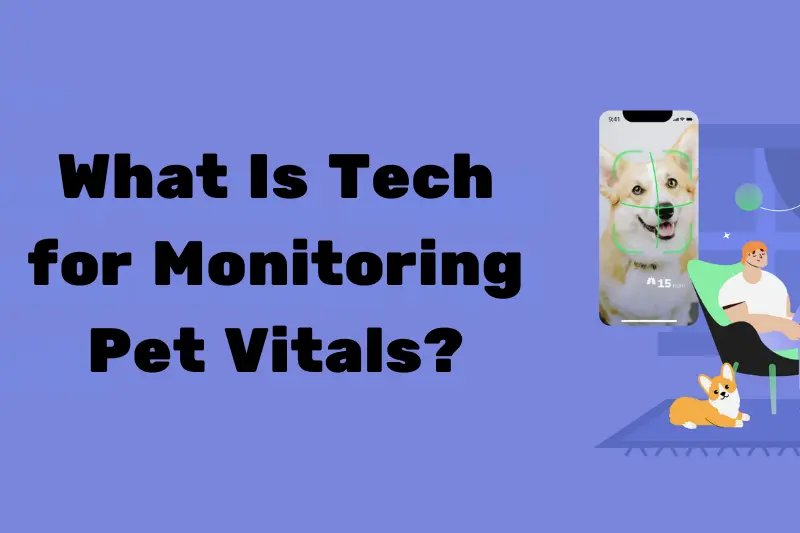Wouldn’t it be amazing if your pet could tell you how they feel? While they may not speak your language, today’s technology is bringing us closer than ever to understanding our pets—right down to their heartbeat, stress levels, and sleeping habits. Welcome to the world of tech for monitoring pet vitals—an exciting and fast-evolving space that’s transforming how we care for our beloved animals.
Whether you’re a pet parent, a vet, or an animal care professional, this tech is a game-changer. It’s like giving pets their own wearable fitness trackers—only smarter.
What Is Tech for Monitoring Pet Vitals?

At its core, this refers to wearable or smart technology—like collars, harnesses, or biosensors—designed specifically to track important health metrics in pets. These devices continuously monitor:
- Heart rate
- Respiratory rate
- Body temperature
- Activity and rest patterns
- GPS location
- Stress indicators
- Calories burned
- Posture and mobility
All this data is then sent to your smartphone or vet’s system via apps or cloud-based platforms, where it’s organized in easy-to-understand dashboards.
So, instead of relying on guesswork, you now have real-time insight into your pet’s health—just like humans do with smartwatches and fitness trackers.
Why Is This Tech So Important?
In recent years, the integration of wearable technology in animal health has revolutionized how veterinarians and pet owners monitor and manage pet well-being. This innovation mirrors the way wearables have improved human healthcare, offering real-time data collection, smarter diagnostics, and proactive medical interventions.
Let’s break down the biggest benefits:
1. Early Detection of Health Issues
Wearable devices can detect unusual patterns—like a rise in body temperature or a drop in activity levels—that may signal a developing illness. You get alerts before visible symptoms show up, enabling early intervention.
2. Continuous Monitoring
Gone are the days of annual vet check-ups being the only source of health data. With tech for monitoring pet vitals, health data is being collected 24/7, giving you and your vet a much more complete picture.
3. Enhanced Communication with Veterinarians
These devices often sync with vet platforms, so your pet’s entire health history is accessible in one place. This helps vets make faster, more accurate diagnoses and better treatment decisions.
4. Stress-Free Monitoring
No need to drag your pet to the clinic for every minor concern. Devices track vitals passively, in your pet’s natural environment. This reduces stress for pets—especially cats and anxious dogs.
5. Improved Chronic Disease Management
For pets with ongoing health issues like diabetes, heart conditions, or arthritis, wearable tech makes it easier to track symptoms, monitor responses to medication, and adjust care plans dynamically.
6. Peace of Mind for Pet Owners
Let’s be honest—most of us worry when we’re away from our pets. These devices provide remote monitoring, real-time alerts, and even GPS tracking to ensure your furry friend is safe, healthy, and where they’re supposed to be.
Who’s Using It?
It’s not just individual pet parents—veterinary clinics, animal shelters, pharmaceutical companies, and animal researchers are also jumping on board.
For example:
- Vets use it for post-surgery monitoring or checking chronic cases remotely.
- Shelters use it to assess stress levels in newly rescued animals.
- Researchers use the data for clinical trials and behavior studies.
- Farmers are deploying it on livestock to improve productivity and welfare.
This level of widespread adoption shows how deeply integrated and trusted this tech has become.
You may also like to read this:
Top Dog Wearable Devices For Health And Safety In 2025
Top Smart Pet Health Monitors For Better Pet Care
Best Pet Fitness Tracking Devices For Health & Safety 2025
AI Technology For Pets: Benefits And Latest Trends 2025
AI Pet Behavior Analysis: Revolutionizing Pet Care Today
Pet Health Apps with AI: Transforming Pet Care In 2025
Popular Devices in the Market
There’s a growing list of smart pet devices out there, each with unique features. Here are a few noteworthy options:
1. PetPace Smart Collar
- Measures heart rate, temperature, respiratory rate, activity, and more.
- Sends alerts to your phone or vet.
- Ideal for older pets or those with chronic conditions.
2. FitBark
- Syncs with Fitbit, Apple Watch, or Google Fit.
- Tracks fitness, sleep, and behavioral patterns.
- Designed for dogs of all sizes.
3. Whistle Health & GPS Tracker
- Tracks health trends, activity, and location.
- Offers wellness reports and vet record integration.
- Helps detect issues like itching, shaking, or vomiting.
4. Invoxia Smart Dog Collar
- Monitors heart and respiratory rate, movement, and GPS.
- Uses AI to learn your dog’s habits and detect abnormalities.
5. Tailio
- A smart device that fits under your cat’s litter box.
- Tracks weight, urination frequency, and behavior changes.
- Useful for early detection of kidney and urinary issues.
The Future of Pet Health Tech

The future is looking even more advanced—and exciting.
Here’s what we can expect next:
- AI-powered analytics: Imagine your device detecting not just symptoms, but predicting potential diseases.
- Integration with telemedicine: Your pet’s data could be instantly shared with online vets during virtual visits.
- Personalized health insights: Data-driven recommendations on food, exercise, and treatments.
- Multi-species support: From cats and dogs to birds, reptiles, and livestock—tech is evolving to support a wider range of animals.
As this technology matures, it won’t just track health—it will help prevent illness, extend lifespans, and improve the overall quality of life for our pets.
How to Choose the Right Tech for Monitoring Pet Vitals
With so many smart collars, sensors, and apps on the market, it can be overwhelming to figure out which one is right for your furry friend. Here’s a simple checklist to guide you:
✅ 1. Understand Your Pet’s Needs
Different pets, breeds, and ages have different requirements. A young, active dog might benefit from activity tracking, while an older pet with arthritis might need vitals monitoring.
Ask yourself:
- Is your pet healthy, or managing a chronic condition?
- Is your priority fitness, location tracking, or health monitoring?
- Is your pet a cat, dog, or another species?
✅ 2. Look for Essential Features
Not every device has all features, so look for the most relevant ones:
- Heart rate and respiration: Crucial for detecting illness early.
- Temperature monitoring: Helpful in spotting fevers or infections.
- GPS tracking: Great for adventurous or escape-prone pets.
- Activity tracking: Good for weight management and behavior.
- Sleep and rest patterns: Important for aging or sick pets.
✅ 3. Vet Integration
Some wearables can share data directly with your vet, allowing them to monitor your pet remotely. This is especially useful for:
- Chronic conditions
- Post-surgery recovery
- Senior pet care
✅ 4. Comfort and Fit
Choose a device that’s lightweight and won’t bother your pet. Look for water resistance if your pet enjoys swimming or outdoor adventures.
✅ 5. Battery Life and App Support
Longer battery life and a user-friendly app make your experience smooth and hassle-free. Also, check if the app provides health tips and alerts.
Tips for Getting Started
Here are a few helpful steps to introduce your pet to their new tech without stress:
🐶 1. Gradual Introduction
Let your pet sniff and explore the device first. Put it on during relaxed times like naps or feeding.
📱 2. Sync With Your Smartphone
Install the companion app and connect the device via Bluetooth or Wi-Fi. Set up your pet’s profile with age, breed, weight, and any medical conditions.
💡 3. Monitor Trends, Not Just Daily Stats
Don’t panic over one unusual reading. Instead, watch for patterns over days and weeks—just like human health tracking.
🩺 4. Share Data With Your Vet
Many apps let you export data or share reports directly with your vet. This can be a goldmine of info during checkups or emergencies.
🎯 5. Set Goals and Alerts
Use the app to set goals—like step counts or rest hours—and enable alerts for unusual vitals. That way, you’ll always be one step ahead.
Challenges and Considerations
While this technology is incredibly promising, there are a few challenges and considerations to keep in mind:
- Accuracy and Reliability: Not all devices offer the same level of precision. It’s important to choose products that have been tested and validated, ideally with veterinary input.
- Data Privacy: As with any connected device, data security is essential. Make sure the company you choose has strong privacy policies to protect your pet’s health data.
- Cost: High-tech pet wearables can be expensive, and some require monthly subscription fees for app services or cloud data storage.
- Pet Comfort and Acceptance: Some pets may take time to adjust to wearing collars or sensors. It’s important to prioritize comfort and not force the device on pets who are overly stressed by it.
- Limitations of Technology: While wearables provide valuable data, they are not a substitute for professional veterinary care. Always consult your vet if you notice unusual symptoms.
Real-Life Success Stories
To illustrate how this technology is already making a difference, here are a few examples:
- Max the Golden Retriever: Max’s owner noticed a sudden drop in his activity and increased respiratory rate through their smart collar. A vet visit revealed early-stage heart disease, and Max was able to get treatment before symptoms worsened.
- Luna the Cat: Luna’s litter box sensor alerted her owner to frequent urination and weight loss. Early detection led to a timely diagnosis of a urinary tract infection, avoiding serious complications.
- Shelter Dogs: An animal shelter used wearable monitors to track stress levels in newly rescued dogs. This helped staff identify the most anxious dogs and tailor enrichment activities to help them adjust faster.
Conclusion
Tech for monitoring pet vitals is revolutionizing how we care for our animals by providing continuous, real-time health data. These devices enable early detection of illnesses, improve management of chronic conditions, and reduce stress by allowing pets to be monitored in their natural environment. Although not a substitute for professional veterinary care, this technology enhances communication between pet owners and vets, offering more personalized and proactive healthcare.
As these tools advance with AI and telemedicine integration, they promise to extend pets’ lifespans and improve their quality of life—making it easier than ever to keep our furry friends healthy and happy.
FAQs
1. What types of health metrics can pet monitoring devices track?
Most devices track heart rate, respiratory rate, body temperature, activity levels, sleep patterns, GPS location, stress indicators, and sometimes even calories burned and posture.
2. Are these devices suitable for all pets?
While many devices are designed for dogs and cats, some are expanding to other animals like birds, reptiles, and livestock. Always check if the device is appropriate for your pet’s species, size, and age.
3. How accurate are these pet vital monitoring devices?
Accuracy varies by device and brand. It’s best to choose products validated through veterinary testing and to use the data as a guide rather than a definitive diagnosis.
4. Can the data be shared with my veterinarian?
Yes, many devices sync with apps that allow you to share health reports and live data with your vet, helping them provide better remote care and faster diagnosis.
5. Will my pet be comfortable wearing these devices?
Most devices are designed to be lightweight and comfortable, but some pets may need time to adjust. It’s important to choose a device that fits well and doesn’t cause irritation.


